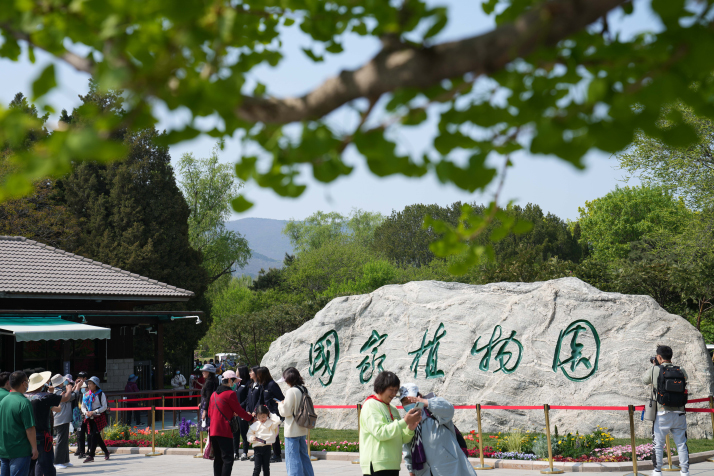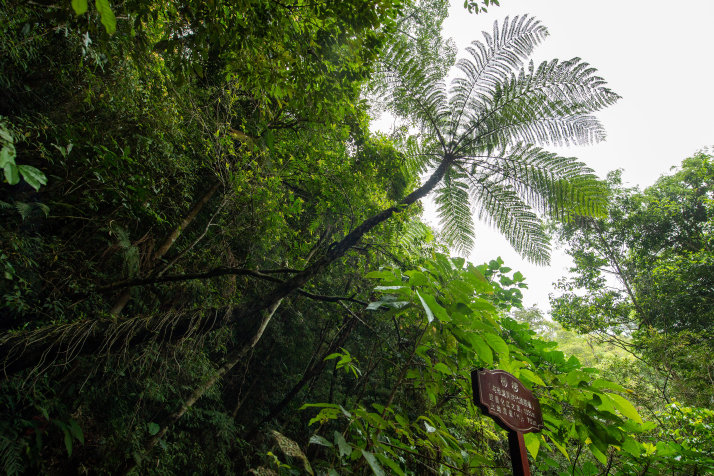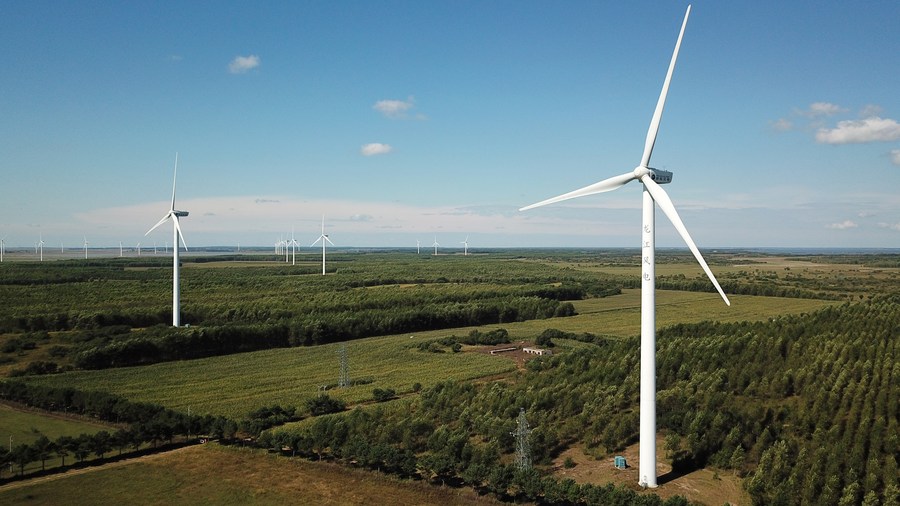A Greener Decade

With the green development concept becoming engrained in every aspect of production and people’s lives, a Beautiful China, where humans and nature live in harmony, is turning from blueprint into reality.
The China National Botanical Garden was officially inaugurated in Beijing on April 18. With a planned area of 600 hectares, the garden features more than 30,000 kinds of plants and 5 million plant specimens from five continents.
The botanical garden, which contributes to biodiversity and harmony between humans and nature, is an epitome of the country’s sustainable development. It is part of the efforts China has made to promote ecological progress since the 18th National Congress of the Communist Party of China (CPC) in 2012.
“Since the 18th CPC National Congress, the CPC Central Committee has devoted greater efforts than ever before to ecological conservation. The whole Party and the entire nation have become more conscious and active in pursuing green development, and made significant progress in building a Beautiful China,” read a resolution on the Party’s major achievements and historical experience in the past century, passed during the Sixth Plenary Session of the 19th CPC Central Committee, held from November 8 to 11 last year.
It noted that the CPC Central Committee has emphasized that ecological conservation is of vital importance for the sustainable development of the Chinese nation.
“To protect the environment is to protect the productive forces, and to improve the environment is to boost the productive forces,” said the resolution.

Political and legal guarantees
Since 2012, green development has gained greater momentum as the idea that “green is gold” conceptualized by President Xi Jinping has taken root in the country.
In the report to the 18th CPC National Congress in 2012, ecological development was included as a major task in the country’s overall plan and the report proposed building a Beautiful China as a grand goal for ecological progress.
Eco-civilization was also included in the CPC Constitution as a development principle during that CPC national congress. It was the first time in the world that a ruling party had highlighted green development in its guidelines.
The Amendment to the Party Constitution passed at the 19th CPC National Congress in 2017 reiterated the vision that “green is gold.” In 2018, ecological progress was written into the Constitution.
According to the resolution adopted by the CPC Central Committee last year, the country’s environmental protection endeavors have resulted in sweeping, historic and transformative changes.
Amending the environmental law is one such endeavor. In January 2015, the revised Environmental Protection Law came into force. The law, considered China’s strictest anti-pollution legislation, stipulates tougher punishments for polluters, including daily, uncapped fines and court sentences.
The revised law gives the environmental protection authorities a wider range of powers to shut down companies with excessive emission levels or to seal their facilities to prevent them from polluting the environment.
It has also clearly spelled out local governments’ responsibility to ensure environmental quality and specified that they would be held accountable for failure to do so.
“China has enacted or revised 13 laws and 17 administrative regulations covering the prevention and control of air, water and soil pollution, accompanied by meticulous efforts to guarantee the laws are strictly enforced,” Ye Min, Vice Minister of Ecology and Environment, said at the press conference on China’s progress and reform in economy and ecological conservation, hosted by the Publicity Department of the CPC Central Committee on May 12.
The strict legal system has become a powerful weapon for curbing environmental transgressions.

Improved environment
Over the past decade, China’s environment has significantly improved. Last year, the share of days with good air quality in major cities rose to 87.5 percent, up 0.5 percentage points from 2020, according to the Ministry of Ecology and Environment (MEE) in January. The improvement has been made thanks to the Air Pollution Prevention and Control Action Plan released by the State Council in 2013. The plan set the target of reducing the concentrations of PM2.5—harmful particles with a diameter of 2.5 microns or less—in cities at or above the prefecture level by 10 percent by 2017 from the 2012 levels.
Since the plan was implemented, air quality in China has improved remarkably. From 2013 to 2019, the concentration of sulfur dioxide, nitrogen dioxide and PM2.5 in the 74 major cities was reduced by 75 percent, 23 percent and 47 percent respectively. The improved air quality has greatly improved people’s happiness and sense of fulfillment.
In April 2015, the Action Plan for Prevention and Control of Water Pollution was implemented. The plan set the goal of increasing the proportion of good quality water of seven key rivers including the Yangtze River, Yellow River and Pearl River to over 70 percent by 2020 and over 75 percent by 2030. It also vowed to reduce the proportion of black and malodorous water bodies in cities at or above the prefecture level to below 10 percent by 2020 and completely eliminate such water bodies in these cities by 2030.
River and lake chiefs have been designated across the country who are responsible for supervising work related to water resource protection and water pollution prevention and control.
In 2021, the proportion of surface water with good quality reached 84.9 percent, up 18.9 percentage points from that in 2015, according to the MEE in January.
Afforestation efforts have been enhanced over the past decade. Since the 18th CPC National Congress, China’s forest coverage had increased by 2.68 percentage points to 23.04 percent in 2020, according to statistics from the National Forestry and Grassland Administration. Voluntary tree planting has been promoted to mobilize the whole society to take part in afforestation. From 1981 to the end of 2021, there had been 17.5 billion instances of voluntary tree planting, with 78.1 billion trees planted.
The urban and rural living environment has also been improved. According to the Ministry of Housing and Urban-Rural Development in June last year, the area of green space in urban areas had reached over 2.3 million hectares, increasing by nearly 50 percent from that in 2012. As of the end of 2020, the proportion of villages with centralized treatment of domestic sewage surpassed 90 percent and over 68 percent of rural households had sanitary toilet facilities, according to the National Rural Revitalization Administration.
Thanks to the country’s conservation efforts, it has made significant progress in protecting biodiversity. Official statistics show that the country’s wild giant panda population has increased to over 1,800, that of the wild Asian elephant has increased to 300, that of the wild Tibetan antelope has increased from 60,000-70,000 in the late 1990s to 300,000 and that of black-faced spoonbill has increased from just over 1,000 at the beginning of the 21st century to over 4,000. The Przewalski’s horse and elk, which had become extinct in the wild, have reestablished their wild populations. With hundreds of giant pandas born during the period from 2004 to 2014, the animal’s conservation status has been changed from endangered to vulnerable.
Similar ecological success stories have been emerging across the country. On October 12 last year, when addressing the Leaders’ Summit of the 15th Meeting of the Conference of the Parties to the Convention on Biological Diversity, or COP 15, via video link, President Xi Jinping announced that China had officially established its first group of national parks, including the Three-River-Source National Park, the Giant Panda National Park, and the Northeast China Tiger and Leopard National Park. The protected area of the five national parks is about 230,000 square km, covering nearly 30 percent of the national key protected wildlife species on land.

On April 12, the Hainan Tropical Rainforest National Park, the only habitat of the Hainan gibbon, a rare primate, announced that one such primate had been born, bringing the population of the species to 36. “There have been baby gibbons born every year in the past three years, which means efforts to protect the species have paid off,” said Huang Jincheng, head of the bureau that manages the national park.
On the way to carbon neutrality
While China improves its domestic environment, it also contributes to global environmental governance. China has become an important participant, contributor and leader of global ecological development.
China aims to peak carbon dioxide emissions before 2030 and achieve carbon neutrality before 2060, President Xi announced at the General Debate of the 75th Session of the United Nations General Assembly via video link in September 2020.
China is committed to phasing out outdated production capacity in cement, plate glass and other industries, replacing coal for non-industrial sectors with cleaner energy and promoting energy conservation and emissions reduction in key industries. “In the past decade, the carbon dioxide emissions per unit of GDP have dropped by around 34 percent,” Han Wenxiu, a senior official with the Central Committee for Financial and Economic Affairs, said at the press conference.
Great efforts have been made to adjust the energy structure and develop green and low-carbon energies. China’s installed capacity of renewable energy power generation totaled 930 million kW by the end of 2020, accounting for 42.4 percent of the country’s total, up 14.6 percentage points against that in 2012, according to the National Energy Administration.

Innovative measures have been taken to reduce emissions. China Carbon Emission Trade Exchange, China’s national carbon market and the world’s largest by volume of emissions, started operation on July 16 last year. The objectives of the national carbon market are to reduce carbon emissions through trading. The trading scheme works by first setting caps on carbon dioxide emissions, then allowing price discoveries for carbon emissions through trading among participants in the market. Provided that carbon prices are high enough, such trading provides companies with financial incentives to save money by cutting emissions in the most cost-effective ways. The power industry was the first industry incorporated into the program, with over 2,000 power companies joining the market, accounting for over 40 percent of China’s emissions. Once fully implemented, the market will cover large firms in seven additional sectors: petroleum refining, chemicals, nonferrous metal processing, building materials, iron and steel, paper and pulp, and aviation.
The Chinese people are adopting a green and low carbon lifestyle. China sold 3.5 million electric cars and plug-in hybrids in 2021, up 160 percent year-on-year, according to the Ministry of Industry and Information Technology in February. A Clear Your Plate campaign was launched in 2020 to reduce food waste and garbage sorting has been promoted across the country to advance resource recycling and reduce pollution.
With the green development concept becoming engrained in every aspect of production and people’s lives, a Beautiful China, where humans and nature live in harmony, is turning from blueprint into reality.
 Facebook
Facebook
 Twitter
Twitter
 Linkedin
Linkedin
 Google +
Google +










